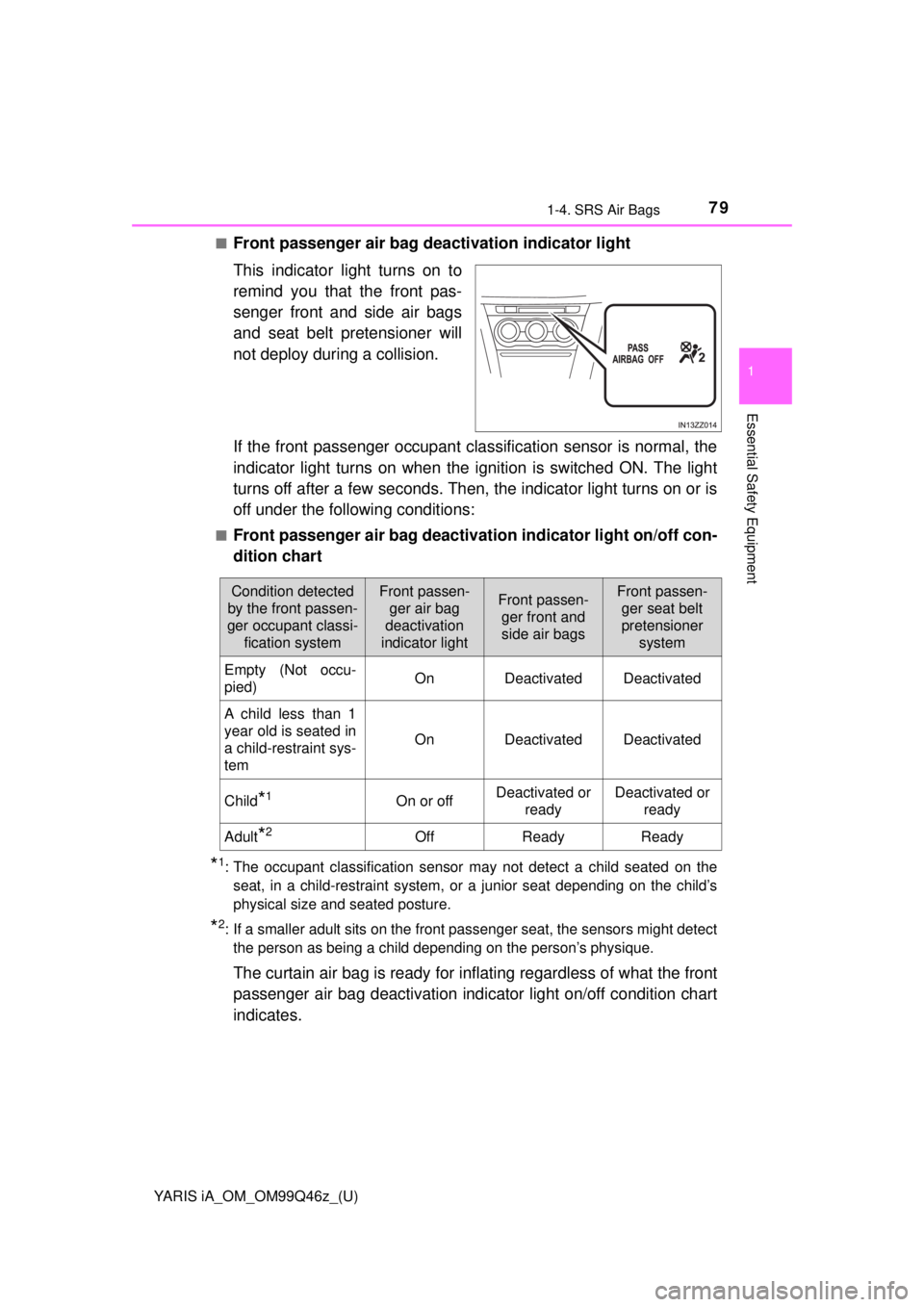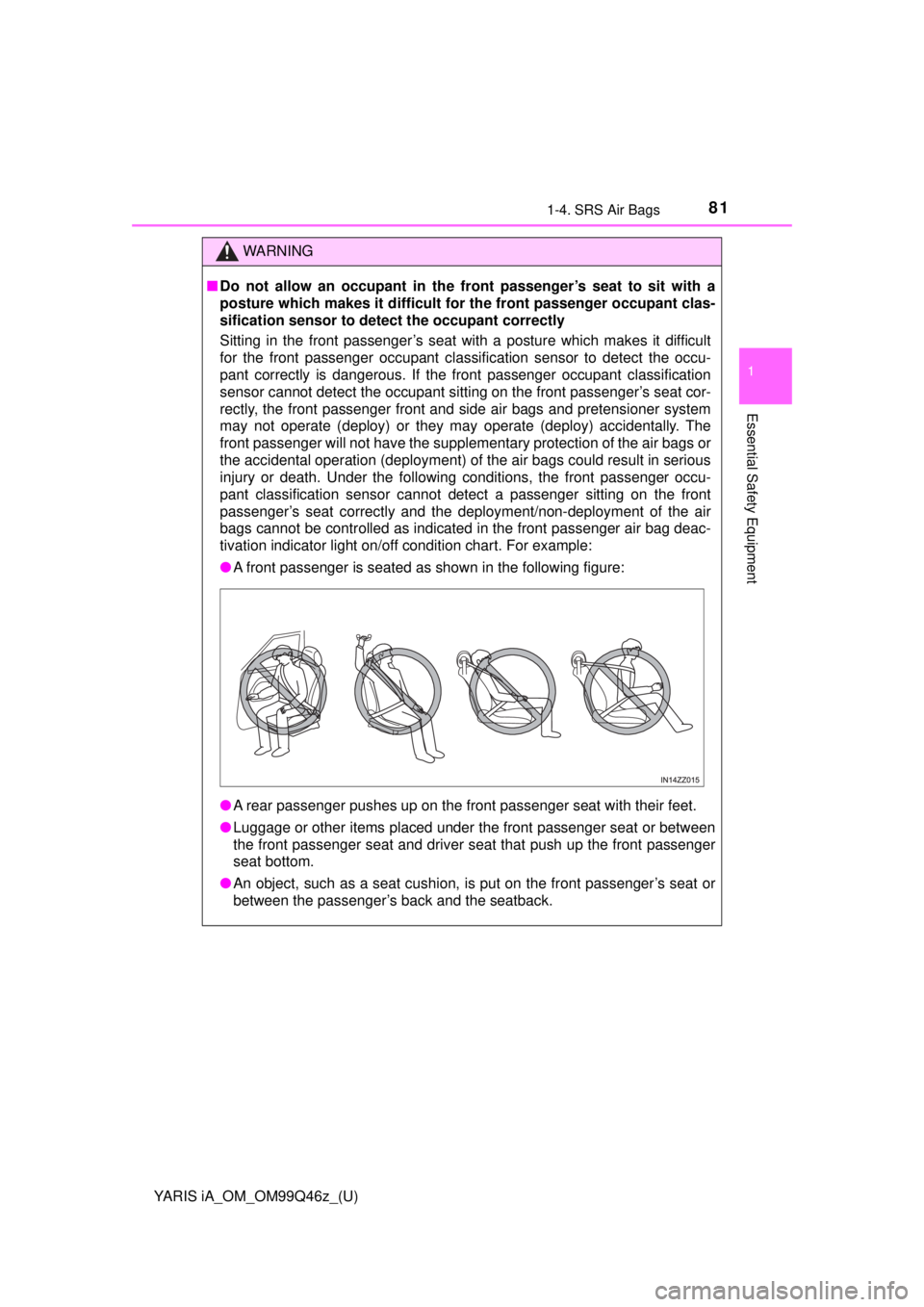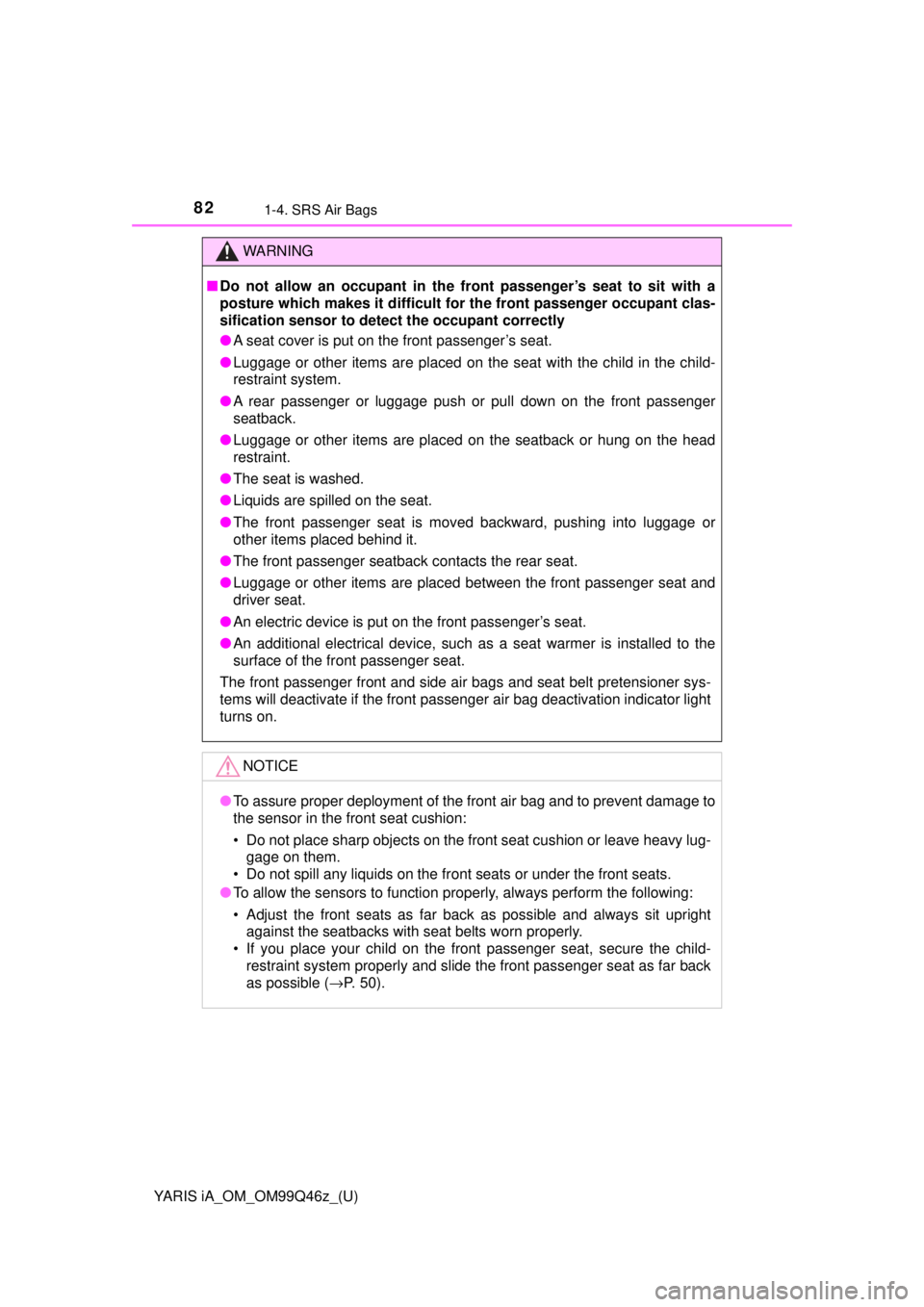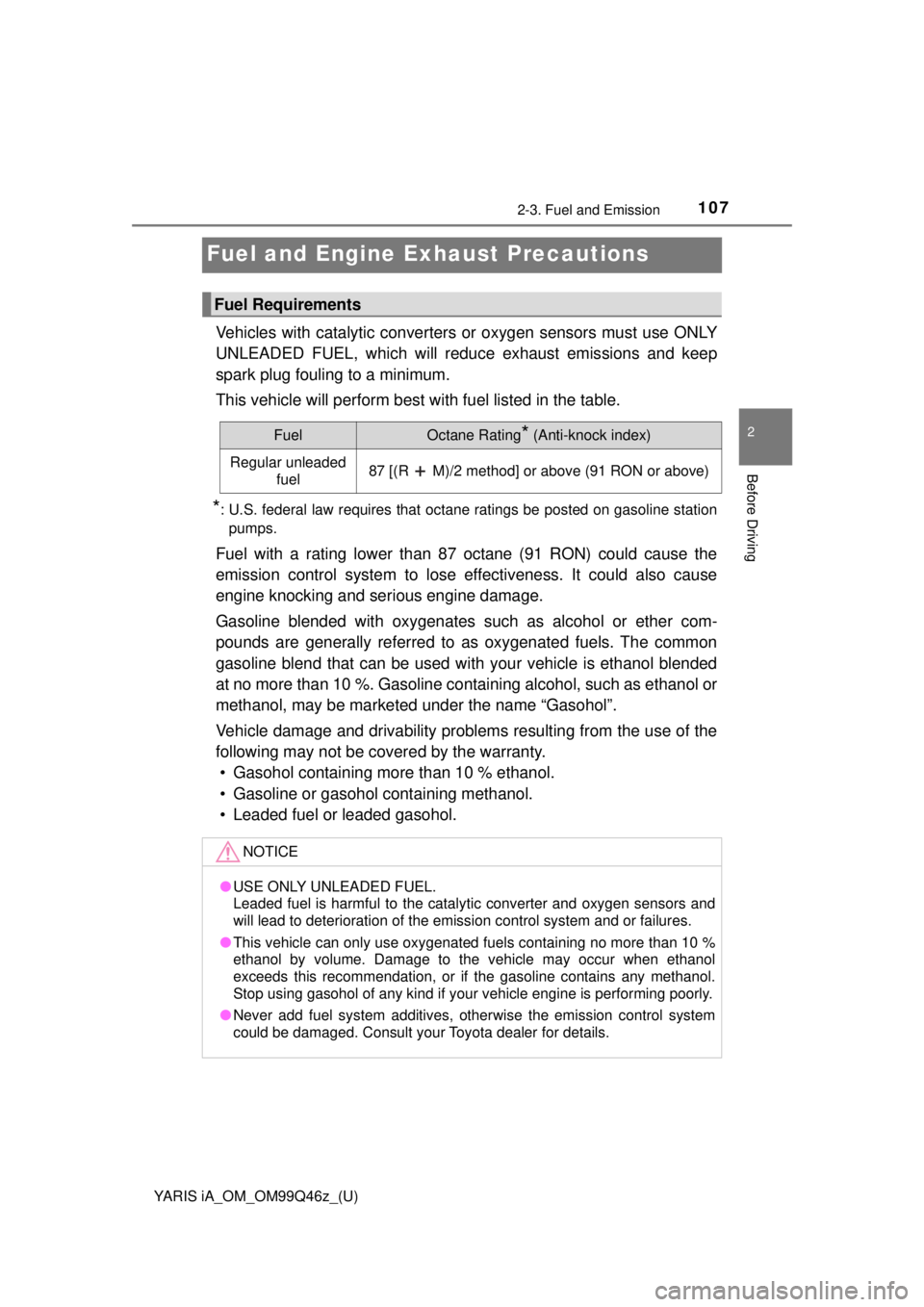Page 79 of 576

YARIS iA_OM_OM99Q46z_(U)
791-4. SRS Air Bags
1
Essential Safety Equipment
■Front passenger air bag deactivation indicator light
This indicator light turns on to
remind you that the front pas-
senger front and side air bags
and seat belt pretensioner will
not deploy during a collision.
If the front passenger occupant classification sensor is normal, the
indicator light turns on when the ignition is switched ON. The light
turns off after a few seconds. Then, the indicator light turns on or is
off under the following conditions:
■Front passenger air bag deactivat ion indicator light on/off con-
dition chart
*1: The occupant classification sensor may not detect a child seated on the seat, in a child-restraint system, or a junior seat depending on the child’s
physical size and seated posture.
*2: If a smaller adult sits on the front passenger seat, the sensors might detectthe person as being a child depending on the person’s physique.
The curtain air bag is ready for inflating regardless of what the front
passenger air bag deactivation indi cator light on/off condition chart
indicates.
Condition detected
by the front passen-
ger occupant classi-
fication systemFront passen-ger air bag
deactivation
indicator lightFront passen- ger front and
side air bagsFront passen- ger seat belt
pretensioner
system
Empty (Not occu-
pied)OnDeactivatedDeactivated
A child less than 1
year old is seated in
a child-restraint sys-
tem
OnDeactivatedDeactivated
Child*1On or offDeactivated or readyDeactivated or ready
Adult*2OffReadyReady
Page 81 of 576

YARIS iA_OM_OM99Q46z_(U)
811-4. SRS Air Bags
1
Essential Safety Equipment
WARNING
■Do not allow an occupant in the front passenger’s seat to sit with a
posture which makes it difficult fo r the front passenger occupant clas-
sification sensor to detect the occupant correctly
Sitting in the front passenger’s seat with a posture which makes it difficult
for the front passenger occupant classification sensor to detect the occu-
pant correctly is dangerous. If the front passenger occupant classification
sensor cannot detect the occupant sitting on the front passenger’s seat cor-
rectly, the front passenger front and side air bags and pretensioner system
may not operate (deploy) or they may operate (deploy) accidentally. The
front passenger will not have the supplementary protection of the air bags or
the accidental operation (deployment) of the air bags could result in serious
injury or death. Under the following conditions, the front passenger occ\
u-
pant classification sensor cannot detect a passenger sitting on the front
passenger’s seat correctly and the deployment/non-deployment of the air
bags cannot be controlled as indicated in the front passenger air bag deac-
tivation indicator light on/off condition chart. For example:
● A front passenger is seated as shown in the following figure:
● A rear passenger pushes up on the front passenger seat with their feet.
● Luggage or other items placed under the front passenger seat or between
the front passenger seat and driver seat that push up the front passenger
seat bottom.
● An object, such as a seat cushion, is put on the front passenger’s seat or
between the passenger’s back and the seatback.
Page 82 of 576

82
YARIS iA_OM_OM99Q46z_(U)
1-4. SRS Air Bags
WARNING
■Do not allow an occupant in the front passenger’s seat to sit with a
posture which makes it difficult fo r the front passenger occupant clas-
sification sensor to detect the occupant correctly
● A seat cover is put on the front passenger’s seat.
● Luggage or other items are placed on the seat with the child in the child-
restraint system.
● A rear passenger or luggage push or pull down on the front passenger
seatback.
● Luggage or other items are placed on the seatback or hung on the head
restraint.
● The seat is washed.
● Liquids are spilled on the seat.
● The front passenger seat is moved backward, pushing into luggage or
other items placed behind it.
● The front passenger seatback contacts the rear seat.
● Luggage or other items are placed between the front passenger seat and
driver seat.
● An electric device is put on the front passenger’s seat.
● An additional electrical device, such as a seat warmer is installed to t\
he
surface of the front passenger seat.
The front passenger front and side air bags and seat belt pretensioner sys-
tems will deactivate if the front passenger air bag deactivation indicator light
turns on.
NOTICE
● To assure proper deployment of the front air bag and to prevent damage to
the sensor in the front seat cushion:
• Do not place sharp objects on the front seat cushion or leave heavy lug-
gage on them.
• Do not spill any liquids on the front seats or under the front seats.
● To allow the sensors to function properly, always perform the following:
• Adjust the front seats as far back as possible and always sit upright
against the seatbacks with seat belts worn properly.
• If you place your child on the front passenger seat, secure the child-
restraint system properly and slide the front passenger seat as far back
as possible ( →P. 50).
Page 83 of 576
83
YARIS iA_OM_OM99Q46z_(U)
1-4. SRS Air Bags
1
Essential Safety Equipment
Constant Monitoring
The following components of the air bag systems are monitored by a
diagnostic system: • Crash sensors, and diagnostic module (SAS unit)
• Front air bag sensors
• Air bag modules
• Side crash sensors
• Air bag/Front seat belt pretensioner system warning light
• Front seat belt pretensioners
• Related wiring
• Front passenger air bag d eactivation indicator light
• Front passenger occup ant classification sensor
• Front passenger occup ant classification module
The diagnostic module continuously monitors the system’s readiness.
This begins when the ignition is switched ON and continues while the
vehicle is being driven.
Page 107 of 576

107
YARIS iA_OM_OM99Q46z_(U)
2-3. Fuel and Emission
2
Before Driving
Fuel and Engine Exhaust Precautions
Vehicles with catalytic converters or oxygen sensors must use ONLY
UNLEADED FUEL, which will reduc e exhaust emissions and keep
spark plug fouling to a minimum.
This vehicle will perform best with fuel listed in the table.
*: U.S. federal law requires that octane ratings be posted on gasoline station
pumps.
Fuel with a rating lower than 87 octane (91 RON) could cause the
emission control system to lose effectiveness. It could also cause
engine knocking and se rious engine damage.
Gasoline blended with oxygenates such as alcohol or ether com-
pounds are generally referred to as oxygenated fuels. The common
gasoline blend that can be used wi th your vehicle is ethanol blended
at no more than 10 %. Gasoline co ntaining alcohol, such as ethanol or
methanol, may be marketed under the name “Gasohol”.
Vehicle damage and drivability problems resulting from the use of the
following may not be covered by the warranty. • Gasohol containing more than 10 % ethanol.
• Gasoline or gasohol containing methanol.
• Leaded fuel or leaded gasohol.
Fuel Requirements
FuelOctane Rating* (Anti-knock index)
Regular unleaded fuel87 [(R M)/2 method] or above (91 RON or above)
NOTICE
●USE ONLY UNLEADED FUEL.
Leaded fuel is harmful to the catalytic converter and oxygen sensors and
will lead to deterioration of the emission control system and or failures.
● This vehicle can only use oxygenated fuels containing no more than 10 %
ethanol by volume. Damage to the vehicle may occur when ethanol
exceeds this recommendation, or if the gasoline contains any methanol.
Stop using gasohol of any kind if your vehicle engine is performing poorly.
● Never add fuel system additives, otherwise the emission control system
could be damaged. Consult your Toyota dealer for details.
Page 139 of 576

139
YARIS iA_OM_OM99Q46z_(U)
3When Driving
3-1. Start/Stop EngineIgnition Switch ................... 140
Starting the Engine ........... 142
Turning the Engine Off ...... 147
3-2. Combination Meter and Display
Meters and Gauges .......... 148
Warning/Indicator Lights .............................. 156
3-3. Transaxle Manual Transaxle Operation ........................ 160
Automatic Transaxle Controls........................... 164
3-4. Switches and Controls Lighting Control ................. 175
Fog Lights ......................... 179
Turn and Lane-Change Signals ............................ 180
Windshield Wipers and Washer..................... 182
Rear Window Defogger ......................... 185
Hazard Warning Flasher ............................ 186
3-5. Brake Brake System .................... 187
Hill Launch Assist (HLA) ... 191 3-6. ABS/TCS/DSC
Antilock Brake System (ABS) .............................. 193
Traction Control System (TCS) .............................. 194
Dynamic Stability Control (DSC) .............................. 196
3-7. Fuel Economy Monitor Fuel Economy Monitor ...... 199
3-8. Drive Selection Drive Selection (Automatic Transaxle) ..... 201
3-9. Power Steering Power Steering ................. 203
3-10. Active Safety System Active Safety System ........ 204
Smart City Brake Support (SCBS)............................ 205
Laser Sensor..................... 211
3-11. Cruise Control Cruise Control ................... 213
3-12. Tire Pressure Monitoring System
Tire Pressure Monitoring System ............................ 218
3-13. Rear View Monitor Rear View Monitor ............ 222
Page 159 of 576
YARIS iA_OM_OM99Q46z_(U)
1593-2. Combination Meter and Display
3
When Driving
When the ignition is switched ON,
the wrench indicator light is illumi-
nated and then turns off after a
few seconds.
The wrench indicator light is illu-
minated when the preset mainte-
nance period arrives. Verify the
content and perform mainte-
nance.
Refer to Maintenance Monitor on
P. 414.
The light illuminates continuously
when the engine coolant tempera-
ture is low and turns off after the
engine is warm.
If the low engine coolant tempera-
ture indicator light remains illumi-
nated after the engine has been
sufficiently warmed up, the tem-
perature sensor could have a mal-
function. Consult your Toyota
dealer.
Wrench Indicator Light
Low Engine Coolant Temperat ure Indicator Light (Blue)
Page 204 of 576
204
YARIS iA_OM_OM99Q46z_(U)
3-10. Active Safety System
Active Safety System∗
◆Pre-Crash Safety Technology
Pre-crash safety technology is designed to assist the driver in
averting collisions or re duce their severity in situations where they
cannot be avoided.
● Collision damage reduction in low vehicle speed range
Forward driving:
Smart City Brake Support (SCBS) ( →P. 205)
◆Sensor
● Laser sensor
The laser sensor emits a near-infrared laser beam and receives
the beam reflected off the reflec tive surface of a vehicle or
obstruction in front, and the detected beam is then used for mea-
surement. The laser sensor is used for the Smart City Brake
Support (SCBS) system.
The laser sensor is installed at the top of the windshield near the
rearview mirror.
Refer to Laser Sensor on P. 211.
∗: If equipped